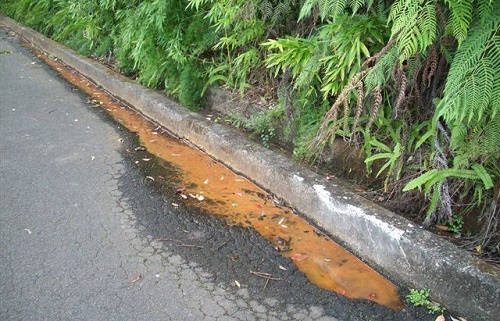Water pollution
Pollution such as chemicals in waterways can cause extensive damage and is often expensive to clean up.
If you notice pollution such as sediment, paint or chemicals in a local waterway, please contact us immediately. It is important to begin cleaning up pollution as soon as possible to limit their damage.
How to report
The following information when making the report can assist in the correct management of an incident:
- Location.
- Time and date.
- What it looks and smells like.
- Whether you witness the pollution incident first hand.
- Your contact details.
If you see someone dumping rubbish or garden waste into or near a waterway please help us by reporting illegal dumping.
Urban sewage
Sewage leading and overflowing into local waterways is a major pollution problem. Urban sewerage systems have inbuilt overflow points in creeks and stormwater drains. These are designed to protect assets from blockages and back flows. Unfortunately, due to illegal stormwater connections, faulty joints, and ageing infrastructure, this occurs more often than intended following rain as stormwater overflows into the sewerage network. This results in sewage pollution within creeks and waterways, which is common in urban streams following significant rainfall. If you notice sewerage in a waterway or overflowing from any infrastructure please contact Sydney Water or call 13 20 90.
Stormwater pollution
Following heavy downpour, many forms of pollution are washing out of the urban environment and into local creek lines through the stormwater system. The stormwater system is separate to the sewerage system and it is vital to correctly dispose of your garbage and ensure only water goes down our street drains. Common items found in the stormwater system include:
- Litter including food packaging, plastic bags, bottles, cans and cigarette butts.
- Chemical pollution, including oil, grease, garden fertilisers and car wash detergent.
- Organic debris such as lawn clippings, leaves and animal waste.
- Sediment pollution from soil erosion and runoff of building sites and cleared bushland.
Simple actions can be taken to prevent stormwater pollution:
- Ensure your cigarette butts and litter ends up securely in a bin.
- Wash your vehicle on the grass, not on the road, or go to your local car wash where waste water drains to the sewerage.
- Rake up garden cuttings and place them in the green bin.
- Sweep your driveway and gutters instead of using the hose.
- Compost your dog’s waste, or use biodegradable bags.
Council manages gross stormwater pollution through a system of water sensitive urban devices.
Iron bacteria
What is it?
If you have noticed a slimy brown/orange residue in your local waterway or drain, it may be iron bacteria, a naturally occurring micro-organism. Iron bacteria is a natural part of the ecosystem and while the visual impacts of iron bacteria are unsightly there is no evidence that suggests the presence of iron bacteria is harmful to our personal health, or the health of our waterways.

Why does it happen?
The presence of iron bacteria in our waterways is associated with the amount of dissolved iron present in the water. Iron bacteria may become evident after heavy rain when iron leaches from the soil into runoff which flows to our waterways. Also, iron becomes more soluble in water where there is little or no oxygen, such as groundwater, so iron bacteria may also be evident during drier times in waterways that receive sub-surface and groundwater flows. When oxygen, water and iron combine they create the right environment for bacteria to bloom. Iron bacteria need to oxidise iron to give them energy. A chemical process occurs, which involves changing ferrous iron (Fe2+) into ferric iron (Fe3+). This process makes the iron insoluble and produces the slimy brown/orange residue you may have noticed in our waterways.
Is it iron bacteria?
There are two quick and simple tests to help you assess that you're looking at iron bacteria and not a pollution incident.
Surface test - poke a stick into the material that looks like an oily film on top of the water. If the surface fractures like ice and does not join back together, it is most likely to be related to iron bacteria. However if the substance clings to your stick and joins back together after breaking the surface, then it could be oil.
Smell test - if the odour smells like decaying matter, this is OK - the odour is most likely caused from the bacteria dying. However, the substance should not smell toxic like sewage, chemicals, petrol or oil.